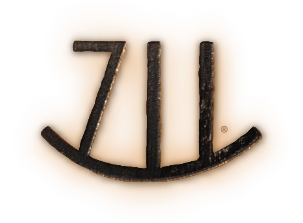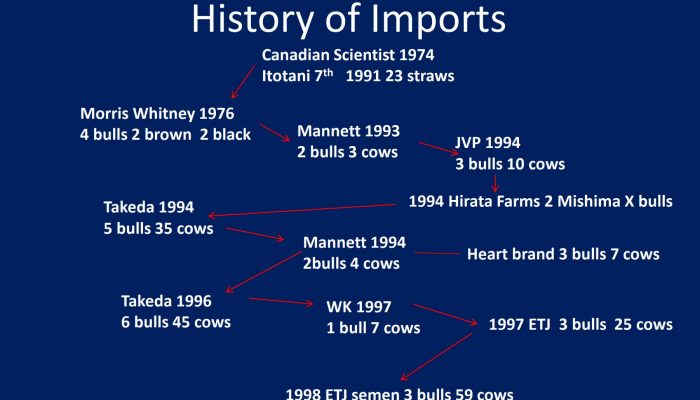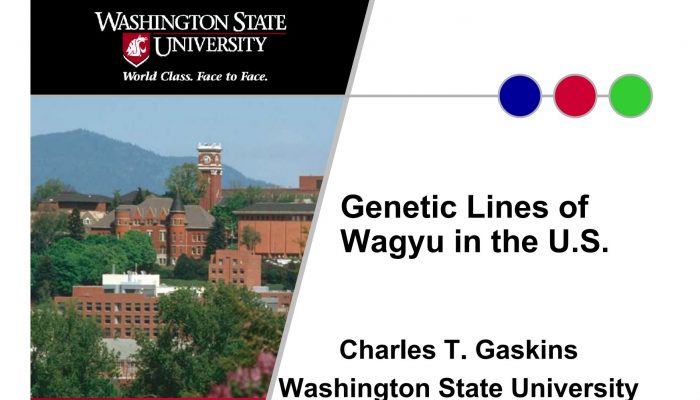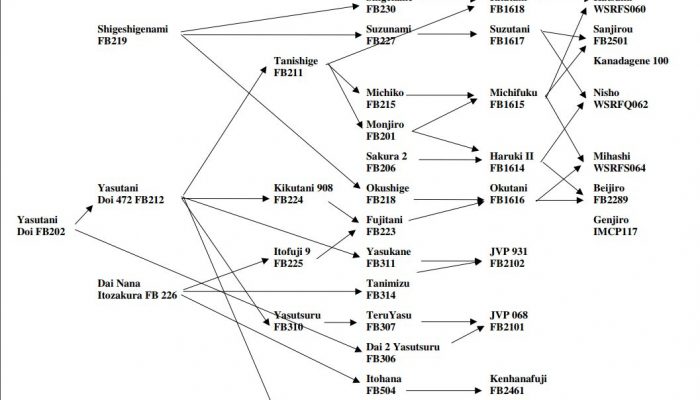Chronological History Of All Wagyu Animals Exported From Japan
During the early years of Wagyu breeding outside Japan, breeding of Wagyu was limited to breeders in the United States, Australia and Canada.
The pool of Wagyu genetics outside of Japan is very limited. The genetics of only 221 individual Wagyu form the basis of the entire worldwide herd of fullblood Wagyu descending from registered Wagyu bloodlines outside of Japan. 183 Wagyu live animals were exported from Japan to the United States. Those 183 live animals gave birth to 27 calves conceived from sires in Japan.
Of the 221 total Wagyu, Black Wagyu—referred to as “Japanese Black” within Japan—made up 188 of the total, consisting of 167 live animals and their 21 calves born after export from Japan. Red Wagyu—referred to as “Japanese Brown” within Japan—made up 22 of the total, consisting of 16 live animals and their six calves born after export from Japan.
The first exports of Wagyu from Japan occurred in 1976 when Morris Whitney shipped two Black Wagyu bulls and two Red Wagyu bulls from Japan to the United States. These four bulls were used for research and Colorado University collected semen. These four bulls were later purchased by Wagyu Breeders Inc.
No additional exports of Wagyu from Japan would occur until 1991, at which time semen from another bull was exported, and then in 1993 a group of both bulls and female Wagyu were exported. Since there were no female Wagyu exported prior to 1993, all Wagyu breeding outside of Japan was of Wagyu bulls crossed with other types of cattle—typically Angus. Prior to 1993—other than the four fullblood bulls exported from Japan in 1976—all Wagyu outside Japan were “crosses” with other types of cattle.
The American Wagyu Association set a standard that the term “fullblood” would be used to describe a Wagyu animal that had descended 100% from the genetics exported from Japan and that the term “purebred” would be used to describe “percentage” Wagyu animals that had descended from a cross breeding of a fullblood Wagyu with cattle of a different breed after “breeding up” to a defined percentage of Wagyu genetics.
No matter how high the percentage of Wagyu blood in a percentage animal, the animal will always be considered a “purebred” rather than a “fullblood”. The term “purebred”, is used to describe an animal that has been “bred up” from the breeding of a fullblood Wagyu bred to an animal of a different breed and then the resulting offspring bred again to a fullblood Wagyu, to at least the 4th generation. At the 4th generation—at which time the offspring is 15/16ths (93.75%) Wagyu genetics—such an animal is referred to and recorded in the American Wagyu Association registry as a “purebred” Wagyu animal.
Between 1976—when the four original fullblood Wagyu bulls were exported from Japan—through 1993 when the first fullblood Wagyu females were exported from Japan, all Wagyu animals born outside of Japan were “percentage” Wagyu, with producers striving to breed their herds up to purebred status and above using the very limited number of bulls that had been exported from Japan. The four original fullblood Wagyu bulls exported from Japan to the United States in 1976 were:
- Mazda, from Tottori, of the Kedaka line
- Mt Fuji, from Hyogo, of the Tajima line
- Rueshaw, from Kumamoto, a Red Wagyu of the Kumamoto Red line
- Judo, from Kumamoto, a Red Wagyu of the Kumamoto Red line
In or around 1991 the extremely narrow genetic base was widened when semen from the 5th bull Itotani was brought to Canada by Lakeside Industries at Brooks.
By 1991 the highest percentage Wagyu bull recorded in the United States was 63/64. At that time it was estimated that there were less than 300 Wagyu crossbred females of breeding age that were 3/4 Wagyu or higher.
In 1993 The Mannett Group—later to become World Ks—imported five more Black Wagyu from Japan to the United States. This time—for the first time—female Wagyu were included in the shipment. The 1993 Mannet Group shipment included two bulls and three females. All five animals were Black Wagyu. The shipment included the following:
- Suzutani, a female of the Tajima line
- Rikitani, a female of the Tajima line
- Okutani, a female that was 75% Tajima and 25% Fujiyoshi
- Michifuku, a bull that was 94% Tajima
- Haruki 2, a bull that was 56% Tajima and 19% Fujiyoshi
The following year in 1994, the first fullblood Wagyu calves to be born outside of Japan were from the three females in the Mannett Group shipment and included:
- Rikihari, born in Canada
- Beijiro, born in the United States
- Suzumichi, born in the United States
Later in 1994 the first live exports from the United States were transported to Wally Rae in Australia.
Also in 1994 the Mannett Group imported an additional four black females—Okahana, Nakayuki, Kanetani and Nakagishi 5—and two black bulls—Kenhanafuji and Takazakura. Calves born after the arrival in the United States were Tanitsuru, Nakazakura, Kitaguni Jr. and Reiko.
In this consignment were Red Wagyu imported by Dr. Al and Marie Wood from selections made by Mr Yikio Kurosawatsu and Dr. King in the Kumamoto prefecture. Nine red females—Namiko, Ume, Namoi, Akiko, Haruko, Fuyuko, Dai 3 Namiaki, Dai 9 Koubai 73 and Dai 8 Marunami—and three red bulls—Shigemaru, Tamamaru and Hikari—are registered in the American Wagyu Associatio.
There are some reports that state that only seven heifers were imported, of which three were pregnant on arrival in the USA. Calves born to this group of imported females that were bred in Japan to Japanese sires Namimaru and Dai 10 Mitsumaru prior to export included Big Al, Kaedemaru, Momigimaru, Ringo, 504 and 505. After a 180-day incubation that was required for quarantine, Namoi, Dai 3 Namiaki, Kaedemaru and Momigimaru were shipped to Ontario in Canada. The remainder of the Red Wagyu herd in United States was subsequently sold to Englewood Farm in Texas. Subsequently, most of those Red Wagyu were transferred to Heart Brand in Texas.
Also in 1994, Japanese Venture Partners imported three black bulls—Kikuyasu, Fukutsuru, Yasutanisakura—and 10 black females, Chisahime 662, Chiyofuku 992, Fukutomi 990, Kikuhana 298, Shigehime 208, Tokuhime 486, Yasufuji 1/4, Yoshifuku 2 and Yuriko 1, and 2 red heifers, Kunisakae and 27 Homare—to the United States.
Also in 1994, Mr Shogo Takeda exported 35 black females—many in calf—and five black bulls—Itomichi 1/2, Kikuhana, Itohana 2, Kinto and Terutani. Numerous calves have been registered to the females in this shipment.
In 1997 the Mannett Group imported 7 black females—Taguchi 9, Nakahana 5, Mitsutaka, Okuito 9, Hanateru 9, Rabito and Hisako—with 1 black bull—Yasufuku Jr. Calves born after arrival were Taguchifuku, Kotomichan and Kousyun.
Chris Walker of Westholme imported 25 black females and three black males—Hirashigetayasu, Itomoritaka and Kitateruyasu Doi—to the USA from ET Japan Company in Hokkaidoo in 1997. The following year another 59 females arrived together with semen from three black bulls—Shigefuku, Dai 6 Seizan and Kitatsurukiku Doi. The bulls remained but the females were exported to Australia. This consignment was diverse with 44 Shimane and 28 Kedaka and 12 Tajima to add milk and size with marbling. Dams which bred in Australia include: Hatsuko, Itoreiko, Kazuaki, Kitahikari 97/1, Kitakazu, Kitaokumi, Kitasakaedoi, Kitasekitori, Kitatizuru 2, Kunikiku 96, Masako, Masatoshi 2, Sakaehikari, Sekinakada 22, Sekiyuhou, Takakuni, Takashigedoi, Yamafuji, Yamaketakafuji 3 and Yuriyuhoi.
Takeda Farms imported six black bulls—Kikutsuru Doi, Itoshigefuji, Itoshigenami, Mitsuhikokura, Kikuterushige, Itozuru Doi.
It is worth noting that a “Mishima” bull (“Kamui”), was in this Takeda Farms consignment. Mishima are a native cattle breed from Mishima Island in Japan. While Mishima cattle are not considered “Wagyu” in Japan because Japan uses the term “Wagyu” to describe only the four breeds of cattle that were derived from the government-led improvement program that started in 1919 (Japanese Black, Japanese Brown, Japanese Polled and Japanese Shorthorn), the Mishima cattle are noteworthy because they are the indigenous cattle of Japan that were not crossed with other breeds of non-Japanese cattle.
The population of Mishima cattle on Mishima Island had been eliminated by Rinderpest disease in 1672. A few Japanese Black cattle were transported to Mishima Island from mainland Japan to re-establish the herd, which cattle have been in-bred for more than 25 generations. Mishima has high marbling but is smaller than the conventional Wagyu breeds of today. Kamui is registered as a “Base Animal”, registration number B115, with a date of birth of August 28, 1991, to enable crossing with Wagyu. His progeny from breeding to registered fullblood Wagyu dams are registered as Wagyu percentage animals (50% Wagyu on the first breeding) by the American Wagyu Association.
The above describes all of the exports of Wagyu from Japan through 1997. In 1997 the Japanese government officially declared Wagyu a national treasure and banned all further exports of live animals and genetics, and no additional Wagyu are known to have been exported after this.



